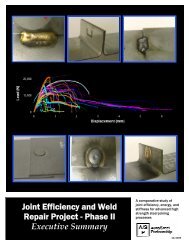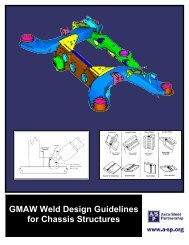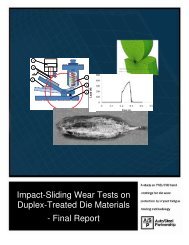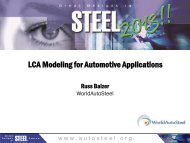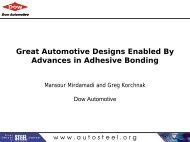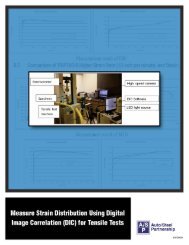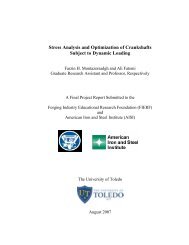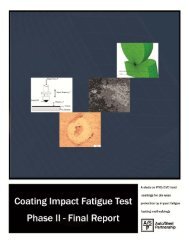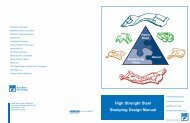Light Truck Frame Joint Stiffness Study Phase 1 Final Report
Light Truck Frame Joint Stiffness Study Phase 1 Final Report
Light Truck Frame Joint Stiffness Study Phase 1 Final Report
Create successful ePaper yourself
Turn your PDF publications into a flip-book with our unique Google optimized e-Paper software.
APPENDIX A: ABSTRACTS<br />
studied were ascending order of stiffness and strength: web cleats, flange cleats, combined seating<br />
cleat and web cleats, flush end plate and extended end plate. Connections to the column flanges and<br />
the column web were included. Major sources of connection flexibility have been identified and the<br />
results prepared for subsequent use in assessments of semi-rigid joint action in steel frames.<br />
12. Through-Thickness Properties of Column Flanges in Welded Moment Connections<br />
Dexter, R. J. (Minnesota University, USA) and Melendrez, M. I. (Disney World Int., USA)<br />
ASCE Journal of Structural Engineering; Jan 2000<br />
Forty tee-joint specimens were tested to assure that through-thickness strength or ductility of the<br />
column flanges is not a potential failure mode for welded moment connections. The specimens were<br />
designed with 690-MPa yield-strength pull plates and a high-strength high-toughness double groove<br />
shop weld (not representative of structural welds) to attempt to induce through-thickness failures in<br />
column flanges. Despite high strain rate, high-heat input welds, and several details designed to<br />
trigger fractures, only one through-thickness failure occurred. In most cases the pull plates broke, and<br />
in all cases the stress levels exceeded 690 MPa, well above the stress level that could be delivered<br />
by structural steel beam flanges. The only specimen fabricated without continuity plates resulted in a<br />
through-thickness brittle fracture of the column flange, although the nominal pull-plate stress was<br />
quite high (698 MPa). The lack of yielding in the through-thickness direction can be explained by the<br />
existence of triaxial constraint of the column flange material.<br />
13. Experimental Analysis of Bolted Connections: Snug Versus Preloaded Bolts<br />
Faella, C., Piluso, V. and Rizzano, G. (Salerno University)<br />
ASCE Journal of Structural Engineering, (USA) Jul 1998<br />
The rotational stiffness of bolted connections can be properly predicted by means of the so-called<br />
'component method.' In this method, the T-stub plays a fundamental role, because it is used to<br />
compute the stiffness contribution of the most important joint components. For this reason, an<br />
experimental analysis on bolted T-stub assemblies has been performed. On the basis of this analysis,<br />
the possibility of predicting the axial stiffness of the T-stub assembly is investigated. In addition, as<br />
the joint behavior is strongly influenced by the bolt preloading, the experimental analysis has been<br />
performed applying three different levels of bolt preloading and, starting from the obtained<br />
experimental results, simple rules to take it into account are suggested. <strong>Final</strong>ly, the reliability of the<br />
relationships derived from the T-stub analysis has been verified through the application of the<br />
component method to the prediction of the rotational stiffness of a wide number of tested specimens<br />
concerning extended end plate connections, both with snug-tightened and pretensioned bolts,<br />
collected in the technical literature.<br />
14. Practical-Theoretical Analysis of Chassis Torsion by Finite Element Analysis<br />
Fragoso, Helio R.<br />
SAE Brasil 93; Paper 931705<br />
The structural calculation of a complete light truck frame using the Finite Element Method requires the<br />
knowledge of the torsional stiffness of the cargo box, cab and front end of the vehicle. This paper<br />
presents a practical way to obtain the necessary data, avoiding the mathematical modeling of the<br />
whole vehicle, to reduce time and machine requirements. Lab measurements of the torsional stiffness<br />
are performed, in the frame alone and with each of the body components, allowing the definition of a<br />
mathematical model for the whole vehicle.<br />
<strong>Report</strong>: A/SP-005-1 <strong>Light</strong> <strong>Truck</strong> <strong>Frame</strong> <strong>Joint</strong> <strong>Study</strong> 73



